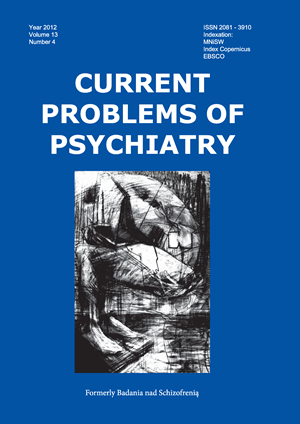Współwystępowanie objawów lęku i depresji w kolejnych trymestrach ciąży
DOI:
https://doi.org/10.12923/j.2081-3910/13.4/a.02Słowa kluczowe:
lęk, depresja, ciążaAbstrakt
Cel pracy. Celem naukowym pracy była analiza występowania objawów lęku i depresji w poszczególnych trymestrach ciąży z uwzględnieniem lęku jako staniu oraz lęku jako cechy.
Materiał i metody. Badanie miało charakter prospektywny, długookresowy; grupę badaną stanowiło 314 pełnoletnich kobiet ciężarnych. Do oceny występowania objawów leku i depresji wykorzystano Szpitalną Skalę Lęku i Depresji (HADS). Do zebrania danych socjodemograficznych i danych medycznych posłużono się kwestionariuszem konstrukcji własnej. Analizę wzajemnej korelacji między badanymi parametrami wykonano z wykorzystaniem testu korelacji rang Spearmana.
Wyniki. Objawów lękowych w pierwszym trymestrze ciąży doświadczyło 27,4% badanych, w drugim trymestrze 23,9%, w trzecim 29,9%. Objawy depresyjne występowały znacznie rzadziej, i tak: w pierwszym trymestrze u 15,3% badanych, w drugim u 12,7% w trzecim u 14%. badanych kobiet. Przynajmniej raz objawów lęku doświadczyło 37,9% badanych, objawów depresji 25,48%. Odsetki badanych kobiet, u których współwystępowały objawy lękowe i depresyjne w poszczególnych trymestrach wynosiły odpowiednio 12,7% badanych w pierwszym, 10,8 % w drugim i 12,4% w trzecim trymestrze ciąży. Objawy lękowe występowały u 15,9% badanych we wszystkich trymestrach ciąży, u 11,5% w dwóch trymestrach. Dla depresji odsetki te wynosiły odpowiednio 3,5% i 9,6. Wykazano związek między nasileniem objawów lęku a nasileniem objawów depresji w poszczególnych trymestrach, przy czym związek ten był silniejszy w pierwszym i trzecim trymestrze niż w drugim trymestrze. Obie skale (lęk jako stan i lęk jako cecha) Inwentarza Stanu i Cechy Lęku korelowały z nasileniem objawów lękowych i depresyjnych (HADS). Lęku jako stan najsilniej korelował z objawami lękowymi w trzecim trymestrze a z depresyjnymi w pierwszym trymestrze. Lęk jako cecha najsilniej korelował z objawami lęku i depresji w trzecim trymestrze.
Wnioski. Wprowadzenie badań skriningowych w kierunku lęku i depresji w ciąży, prowadzonych systematycznie w jej trakcie stwarza szansę wcześniejszej diagnozy i szybszego wdrożenia właściwego postępowania. Wcześniejsza diagnoza i właściwe postępowanie w przypadku wystąpienia lęku i depresji w ciąży stwarza szansę zapobiegania ich skutkom, takim jak depresja poporodowa oraz nieprawidłowy rozwój psychofizyczny dziecka.
Bibliografia
1. Lusskin SI., Pundiak TM., Habib SM. Perinatal depression: hiding in plain sight. Can J Psychiatry. 2007; 52(8): 479-488. https://doi.org/10.1177/070674370705200802
2. Cohen LS., Nonacs RM., Bailey JW. et al. Relapse of depression during pregnancy following antidepressant discontinuation: a preliminary prospective study. Arch Women Ment Health 2004; 7(4): 217-221. https://doi.org/10.1007/s00737-004-0059-3
3. Evans J., Heron J., Patel RR. et al. Depressive symptoms during pregnancy and low birth weight at term: longitudinal study. Br J Psychiatry. 2007; 191: 84-85. https://doi.org/10.1192/bjp.bp.105.016568
4. Alder J., Fink N., Bitzer J. et al. Depression and anxiety during pregnancy: a risk factor for obstetric, fetal and neonatal outcome? A critical review of the literature. J Matern Fetal Neonatal Med. 2007; 20(3): 189-209. https://doi.org/10.1080/14767050701209560
5. Field T., Diego M., Hernandez-Reif M. et al. Chronic prenatal depression and neonatal outcome. Int J Neurosci. 2008; 118(1): 95–103.
6. Rybakowski J., Jaracz J. Leksykon manii i depresji, Termedia, Poznań 2010.
7. Karakuła H., Grzywa A., Śpila B., i wsp. Zastosowanie Skali Leku i Depresji – HADS w chorobach psychosomatycznych. Psych Pol. 1996;30(4):653–668.
8. Wrześniewski K., Sosnowski T., Jaworowska A. i wsp. Inwentarz Stanu i Cechy Lęku STAI. Polska adaptacja STAI. Podręcznik, Pracownia Testów Psychologicznych, Warszawa 2006.
9. Ryan D., Milis L., Misri N. Depression during pregnancy Can Fam Physician 2005; 51: 1087–1093.
10. O'Hara MW. Social support, life events, and depression during pregnancy and the puerperium. Arch Gen Psychiatry. 1986; 43: 569-573.
11. Josefsson A., Berg G., Nordin C. et al. Prevalence of depressive symptoms in late pregnancy and postpartum. Acta Obstet Gynecol Scand. 2001; 80(3): 251-255.
12. Berle JO., Mykletun A., Daltveit AK. et al. Neonatal outcomes in offspring of women with anxiety and depression during pregnancy. Arch Womens Ment Health 2005; 8: 181-189.
13. Lee AM., Keung Lam S., Sze Mun Lau SM. et al. Prevalence, Course Risk Factors for Antenatal Anxiety and Depression, Obstet. Gnecology. 2007; 110(5): 1102-1112.
14. Bennett HA., Einarson A., Taddio A, et al. Prevalence of depression during pregnancy: systematic review. Obstet Gynecol. 2004;103(4):698-709.
15. Marcus SM., Flynn HA., Blow FC. et. al. Depressive symptoms among pregnant women screened in obstetrics settings. J Womens Health. 2003; 12(4): 373-80.
16. Field T., Diego M., Hernandez-Reif M. Prenatal depression effects on the foetus and neonate in different ethnic and socio-economic status groups. J Repr Inf Psychology 2002,20: 149-157.
17. Sutter-Dallay AL., Giaconne-Marcesche V., Glatigny Dallay E., et al. Women with anxiety disorders during pregnancy are at increased risk of intense postnatal depressive symptoms: A prospective survey of the MATQUID cohort. Eur Psychiatry 2004; 19: 459-463.
Pobrania
Opublikowane
Numer
Dział
Licencja
Prawa autorskie (c) 2012 Autorzy

Praca jest udostępniana na licencji Creative Commons Attribution-NonCommercial-NoDerivatives 3.0 Unported License.


